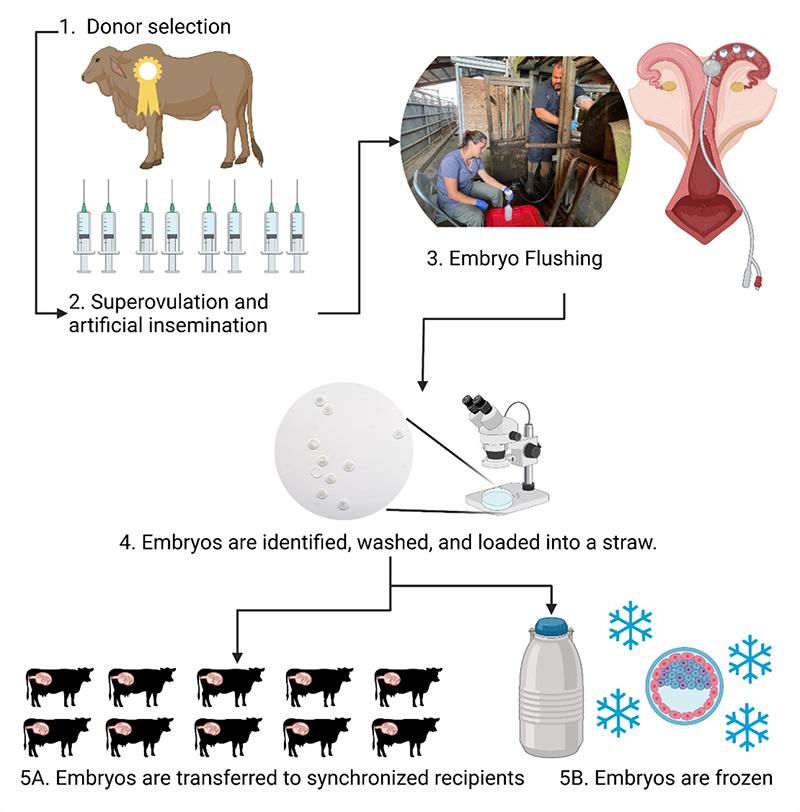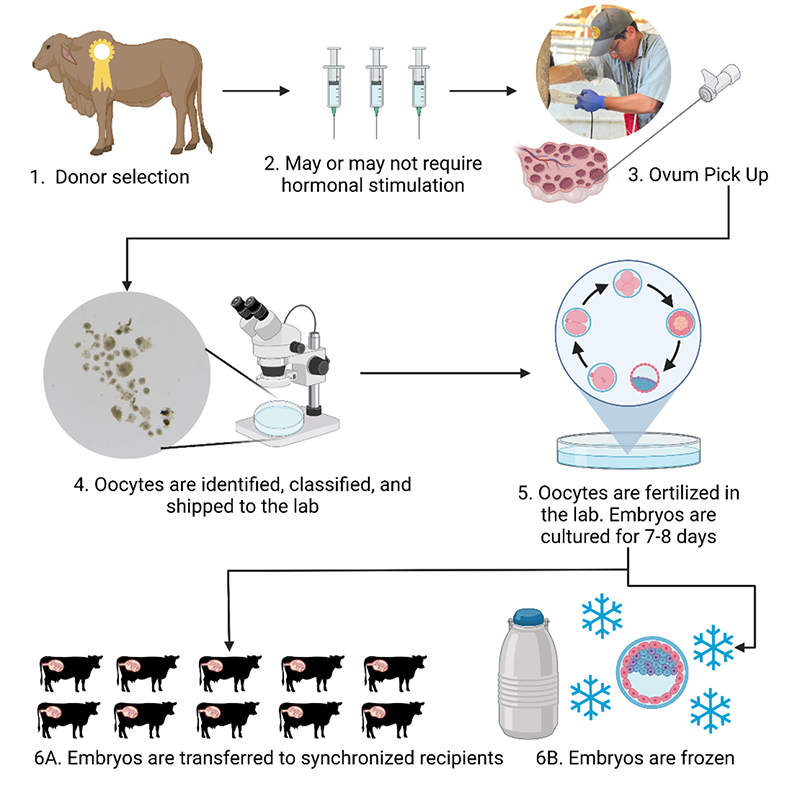Angela Gonella-Diaza. Cattle Reproductive Specialist, UF/IFAS North Florida Research and Education Center
I am sure you have heard about embryo transfer programs before. I know it is tempting to consider using embryo transfer programs for your operation. Reproductive technologies are fascinating, and the possibility of using embryo programs in some operations—especially for those interested in increasing their herds’ genetic merit—is exciting. But hold on! Before calling your favorite embryologist, please read this article! The goal of this article is to explain the basic details of embryo programs, so you can make informed decisions.
–
What is embryo transfer?
Embryo transfer programs are assisted reproductive technologies that aim to produce embryos from a superior donor and transfer them to a surrogate mother: the embryo recipient. There are two ways of producing embryos: in vivo embryo production and in vitro embryo production.
–
How are embryos harvested?
In Vivo
The classic way to produce embryos is in vivo (inside the cow) embryo production, also known as Superovulation programs or Multiple Ovulation and Embryo Transfers (MOET). During superovulation protocols, donor cows are stimulated with exogenous gonadotropins (see Figure 1). The most used gonadotropin all over the globe is highly purified porcine pituitary gland extracts, commonly known as Forltropin (Vetoquinol). This product contains Follicle Stimulating Hormone (FSH), which encourages the growth and ovulation of multiple follicles (instead of just one). As the half-life of FSH is very short (approximately 5 hours), current superovulation protocols using FSH have consisted of two daily doses of intramuscular administrations for 3 to 4 days.
Along with the FSH, other hormones such as progesterone (contained in a CIDR), prostaglandin, and GnRH must be administrated. Typically, donors are inseminated two times. Seven to eight days after the insemination, embryos must be flushed out of the uterus prior to implantation and transferred fresh to a recipient or are frozen in liquid nitrogen, so that they can be transferred later (Cryopreservation). As you would imagine, these protocols are very demanding and labor intensive. Also, the response to the superovulation protocol is highly variable. This means that you can have cows producing 0 embryos and others producing 30 or more. Unfortunately, there is not a good explanation for this variation yet.
–
In Vitro
The other way to produce embryos is by using an in vitro (in a lab) procedure. During in vitro embryo production, oocytes (eggs) are harvested from the cow’s ovaries using Ovum Pick Up (OPU), and the eggs are shipped to a laboratory. Once in the lab, eggs are selected and matured in vitro (in vitro maturation = IVM). Then, semen is thawed, viable sperm cells are chosen, and eggs are fertilized (in vitro fertilization, or IVF). After 24 hours in co-culture with the sperm cells, presumptive embryos are selected and cultured on specialized media (in vitro culture = IVC). After 7 days in culture, embryos are classified and transferred into a recipient or cryopreserved (frozen) for a future transfer (Figure 2).
–
Why are embryo transfer programs being used all over the globe?
Since producing embryos (both in vivo and in vitro) are complicated and labor-intensive, why are people still using these methods? Simply put, embryo programs are now available commercially because they work. Genetic progress can be greatly enhanced by gaining multiple offspring from the best cows.
While artificial insemination, can provide numerous offspring from a single bull, the main idea of embryo transfer programs (both in vivo and in vitro) is to increase the offspring from high-valued females (cow or heifer). This means that the primary goal of this technique is to increase genetic merit. ET programs increase the selection pressure and propagate genetic improvement.
Also, in special cases, it is possible to collect eggs from females as young as two months old and fertilize them in the lab. This approach, therefore, dramatically reduces the generational gap. Finally, embryo programs have been used worldwide to conserve endangered species, including some ruminants or some antique creole livestock breeds.
–
Who is using embryo transfer programs and where?

Figure 3: Number of dairy and beef embryos transferred in the U.S. Data source: Demetrio et al. 2020 (Click to enlarge)
According to the latest USDA report from 2020 (NAHMS Beef 2020), in 2017 only 3% of the cow-calf operations in the U.S. used this technology. But don’t let this small number make you think this is not a significant business.
According to data from the International Embryo Transfer Society (IETS), in 2019 1,419,336 bovine embryos were produced, and 1,117,151 were transferred worldwide, using both in vivo (in cow) and in vitro (in lab) technologies (Viana, 2020). Moreover, the two regions that most contributed to this number were North and South America, with 46% and 39% of the global embryo transfers, respectively (Viana, 2020). This data summarizes both beef and dairy embryo transfers. In the U.S., 68% of the embryos were produced through in vitro production. Texas, Oregon, and Wisconsin were the states where more embryos were transferred in 2019 (Demetrio et al. 2020). As you can see in Fgure 3, in the U.S. in vivo embryo production is decreasing while in vitro embryo production is increasing (Demetrio et al. 2020). The same trend is also found in other countries of the world. For instance, in South America 91% of the embryos transferred in 2019 were in vitro produced (Viana, 2020).
–
When to incorporate embryo programs in your herd?
Before you start an ET program you must have identified high-value donors. Let’s suppose that you have a cow or a heifer with outstanding genetic merit; that is a great starting point. Now, what is outstanding genetic merit?
The answer is tricky, as it depends on each producer, operation type, breed, etc. Currently, it is possible to use genetic testing to evaluate the genetic merit of any individual. However, in most cases, the genetic merit of the donor is assessed by the owner according to her pedigree and offspring performance: the proven performance of calves from that cow or heifer’s family and each individual.
If you have already identified the cow, you must consider that the operation must be ready to adopt the technology. You needed to learn how to crawl before you learned how to walk. The situation is similar when adopting reproductive technologies. It is not a good idea to start an embryo transfer program if you don’t have a successful artificial insemination program in your operation, or if you have never synchronized a cow before. Many of the failures of embryo transfer programs are related to simple problems with the protocols, i.e., failure to follow the schedules and doses of hormones, failure to keep the group of recipients in good body condition and health, failures in the semen or embryos handling, not keeping the nitrogen thank in good condition, etc.
Embryo transfer programs can be a good resource when your donor cow cannot get pregnant. For example, ovaries can be harvested soon after the donor dies and shipped to an IVF lab.
Embryo transfer programs are also recommended when you have very expensive semen and you need to optimize its use. When using artificial insemination, you need one semen straw to produce one calf (if the cow gets pregnant in one attempt). In MOET (the superovulation) programs, each superovulated donor needs to be inseminated two times. This means that you need two straws per donor which can produce several embryos and calves later on. In in vitro fertilization programs, you only need one semen straw to fertilize between 100-300 oocytes (eggs). This means that only one straw is enough to fertilize the eggs harvested from several donors.
–
Summary
To summarize, ET programs are here to stay. Both techniques, in vivo and in vitro, have their strengths and weaknesses. Before you adopt this technology, the most critical decision is to select the donor cow(s).
And remember, if you are curious about these programs, if you want to begin to adopt this technology, or if you are doing it right now but maybe need some assistance, don’t hesitate to get in touch with us! We are here to help you! Contact your local extension agent or state specialists, so that we can give you the support you need to make this investment worthwhile.
–
References:
- Demetrio, D., Looney, C., Rees, H., Werhman, M. 2020 Annual Report of the AETA Statistical Information Committee.
- 2020. Beef 2017: Beef Cow-Calf Management Practices in the United States, 2017. Accessed on November 1, 2021.
- Viana, Joao. “2019 Statistics of embryo production and transfer in domestic farm animals.” Embryo Technology Newsletter, v. 38, n.4, 2020.
- Bull Management for Effective Breeding Performance in Cow-Calf Operations - September 19, 2025
- Heat Stress and its Impact on Cattle Reproduction - March 14, 2025
- Fall is Here.Time for Pregnancy Testing Cattle! - September 13, 2024


